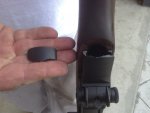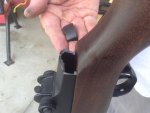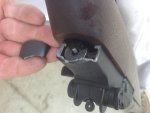Not every double izza slamfire. There's jar-off of a badly worn/"tuned" trigger, "bump" firing when the slowly squeezing trigger finger is in the no-man's land between squeezed follow through and really being released, and the various ways the fining pin by itself (or a very high primer) can light things up.
Jar-off and bump firing ALWAYS involve a hammer that was held back by either the safety sear or the primary sear or if things are working correctly, both in sequence. THEN the hammer falls and fires the cartridge normally. A hammer held back gives the bolt time to lock fully closed. Neither is truly a problem for the survival of an M1 Garand because all the parts go through the full firing cycle. Less time between shots is the only difference between those and "regular" semiauto fire.
AFAIAC, those are not truly slam-fires. But people call box magazines "clips" all the time, too.
Problems arise when it is one of several types of firing pin problems or high primer problems that fires the round. There is the firing pin bouncing around and striking the primer--a very, very low-frequency event because without excessive receiver bridge/firing pin tang (or both) wear because that receiver bridge retracts the FP the last 1/10-inch or less of forward bolt travel. FP stops, bolt finishes going forward. But that is before the lugs rotate locked. A broken firing pin pretty much has to stay stuck forward protruding for this to fire the round because with less mass on the forward part that CAN reach the firing pin, you need more speed than the feed portion of the cycle gives you. This is the most disastrous slam-fire because only inertia and spring pressure resist the bolt flying backwards. That means the bolt flies back way, way too soon and some nasty-high-pressure gas breaches the case and then proceeds to hammer the rest of the entire receiver group and usually splinters the stock.
The Garand's firing pin was made lighter somewhere between the prototypes and the beginning of the gas plug design, IIRC. This was because even with the FP retraction function, that long piece of steel (at least compared to the M14 version), oddities of bouncing and harmonics and for all I know bad Karma could sometimes combine to bounce that firing pin into the primer with enough force to fire the cartridge. This *normally* can happen ONLY if the bolt is rotated at least half-way locked because the FP tang is still held back from any contact with the primer by the receiver bridge camming surface the first half or so of bolt rotation.
By the way, anything prematurely dropping the hammer *should* never result in firing the round unless the bolt is almost completely locked. The first thing that happens when the bolt unlocks is the hammer nose getting cammed back by a camming surface on the rear of the bolt. Not rotated closed = hammer cannot hit the firing pin...unless there's some huge amount of wear or a broken off hammer nose. Never seen any of those in my life, but it is conceivable.
So when there were a LOT of Garands being fired at matches and getting worn out and people were using Federal primers in match loads and all that in the 1980s, there was a notable number of Garand slam-fires with bolts only halfway locked and one of the big wheels at the Rifle and Handloader magazines started calling worn-out Garands "hand grenades". This type of slam-fire also occurred with much less frequency in the more common (at that time) M14 platform, but they did happen. One common factor for many of these was single-loading with the round fully in the chamber AND letting the bolt forward full speed. The plausible theory is that denying the feed system the benefit of stripping the round from the clip or magazine led to excessive forward bolt speed, leading to a lot more firing pin rattle as the bolt was rotating, and whatever other mysterious factors there were all lining up like bad stars in the Zodiac, with the end result being the firing pin striking and igniting the primer with enough force to fire the rifle.
There is a very high likelihood that a true slam-fire will result in excessive bolt and op rod speed, which of course can damage the receiver heel. A locked-hammer double won't result in that because the between shots dwell time is long enough not only for the bolt to close, but for the op rod to go the rest of the way forward to its firing position.
Now, anyone who has a double with any rifle and does not IMMEDIATELY inspect the trigger group for proper sear engagement and functions before firing it again earns any bad consequences that follow.
All that said (I started this last night but went to bed and then to church and a meeting and had lunch today, so I don't know what else has been posted...), I strongly suspect that the broken receiver is a QC/materials/workmanship problem unrelated to the doubling. I will retract this opinion as quickly as the rotating bolt retracts the firing pin tang in a properly-dimensioned Garand IF subsequent investigation shows that the receiver was restored or whatever to have the receiver bridge too close to the receiver ring, making all firing pin retraction and safety functions inoperable--but ONLY if there is also evidence that the bolt was not fully rotated to the locked position when the last round was fired.















